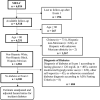Quantifying the Sex-Race/Ethnicity-Specific Burden of Obesity on Incident Diabetes Mellitus in the United States, 2001 to 2016: MESA and NHANES
- PMID: 33563002
- PMCID: PMC7955335
- DOI: 10.1161/JAHA.120.018799
Quantifying the Sex-Race/Ethnicity-Specific Burden of Obesity on Incident Diabetes Mellitus in the United States, 2001 to 2016: MESA and NHANES
Abstract
Background Given the increasing prevalence of diabetes mellitus (DM) in the United States, estimating the effects of population-level increases in obesity on incident DM has substantial implications for public health policy. Therefore, we determined the population attributable fraction, which accounts for the prevalence and excess risk of DM associated with obesity. Methods and Results We included non-Hispanic White, non-Hispanic Black, and Mexican American participants without DM at baseline from MESA (Multi-Ethnic Study of Atherosclerosis) with available data on body mass index and key covariates from 2000 to 2017 to calculate unadjusted and adjusted (age, study site, physical activity, diet, income, and education level) hazard ratios (HR) for obesity-attributable DM. We calculated national age-adjusted prevalence estimates for obesity using data from NHANES (National Health and Nutrition Examination Survey) in 4 pooled cycles (2001-2016) among adults with similar characteristics to MESA participants. Last, we calculated unadjusted and adjusted population attributable fractions from the race/ethnic and sex-specific HR and prevalence estimates. Of 4200 MESA participants, the median age was 61 years, 46.8% were men, 53.9% were non-Hispanic White, 32.9% were non-Hispanic Black, and 13.3% were Mexican. Among MESA participants, incident DM occurred in 11.6% over a median follow-up of 9.2 years. The adjusted HR for obesity-related DM was 2.7 (95% CI, 2.2-3.3). Adjusted population attributable fractions were 0.35 (95% CI, 0.29-0.40) in 2001 to 2004 and 0.41 (95% CI, 0.36-0.46) in 2013 to 2016, and greatest among non-Hispanic White women. Conclusions The contribution of obesity towards DM in the population remains substantial and varies significantly by race/ethnicity and sex, highlighting the need for tailored public health interventions to reduce obesity. Registration URL: https://www.clinicaltrials.gov; Unique identifiers: NC00005487, NCT00005154.
Keywords: diabetes mellitus; obesity; population attributable fraction.
Conflict of interest statement
None.
Figures


References
-
- CDC/US Department of Health and Human Services . National Diabetes Statistics Report 2020 estimates of diabetes and its burden in the United States. 2020:1–30.
-
- Geiss LS, Wang J, Cheng YJ, Thompson TJ, Barker L, Li Y, Albright AL, Gregg EW. Prevalence and incidence trends for diagnosed diabetes among adults aged 20 to 79 years, United States, 1980–2012. J Am Med Assoc. 2014;312:1218–1226. - PubMed
-
- Gregg EW, Hora I, Benoit SR. Resurgence in diabetes‐related complications. J Am Med Assoc. 2019;321:1867–1868. - PubMed
-
- Menke A, Casagrande S, Geiss L, Cowie CC. Prevalence of and trends in diabetes among adults in the United States, 1988–2012. J Am Med Assoc. 2015;314:1021–1029. - PubMed
Publication types
MeSH terms
Associated data
Grants and funding
- N01 HC095163/HC/NHLBI NIH HHS/United States
- N01 HC095168/HC/NHLBI NIH HHS/United States
- KL2 TR001424/TR/NCATS NIH HHS/United States
- N01 HC095162/HC/NHLBI NIH HHS/United States
- UL1 TR001420/TR/NCATS NIH HHS/United States
- N01 HC095165/HC/NHLBI NIH HHS/United States
- N01 HC095169/HC/NHLBI NIH HHS/United States
- N01 HC095159/HC/NHLBI NIH HHS/United States
- N01 HC095161/HC/NHLBI NIH HHS/United States
- HHSN268201500003I/HL/NHLBI NIH HHS/United States
- N01 HC095166/HC/NHLBI NIH HHS/United States
- UL1 TR001079/TR/NCATS NIH HHS/United States
- N01 HC095167/HC/NHLBI NIH HHS/United States
- N01 HC095164/HC/NHLBI NIH HHS/United States
- N01 HC095160/HC/NHLBI NIH HHS/United States
- P30 DK092949/DK/NIDDK NIH HHS/United States
- UL1 TR000040/TR/NCATS NIH HHS/United States
LinkOut - more resources
Full Text Sources
Other Literature Sources
Medical

